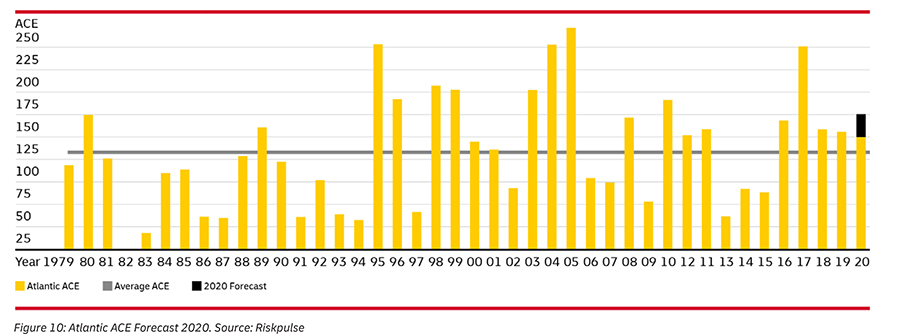Resilience360 and Riskpulse release report on supply chain impacts of 2020 storms
Both Resilience360 and Riskpulse monitor, predict and mitigate potentially disruptive events that can impact the supply chain for global manufacturers, shippers and retailers.

Resilience360 and Riskpulse have jointly released the “2020 Tropical Storm Season Outlook,” which explores what the upcoming tropical storm and hurricane season could bring, and how storm activities may impact supply chains, especially in light of the ongoing COVID-19 pandemic.
Both Resilience360 and Riskpulse monitor, predict and mitigate potentially disruptive events that can impact the supply chain for global manufacturers, shippers and retailers.
“COVID-19 has tested and strained the resilience of global logistics and production operations that will now be forced to also respond to an unpredictable storm season,” said Shehrina Kamal, product director, risk monitoring for Resilience360. “Amid these challenges, supply chain professionals will have to plan in advance on how to address production delays and logistics bottlenecks and be prepared to make quick decisions.”
The report provides a comprehensive view of what to expect from the upcoming tropical storm season, and shares insights on the disruptions and damages from past storms to help organizations prepare.
“Our experts forecast that during the upcoming tropical storm season, companies should expect above normal activity in the Atlantic (Gulf of Mexico, Caribbean, and Atlantic),” said Jon Davis, chief meteorologist, Riskpulse. “As the tropical storm season approaches, organizations faced with balancing the impact of oncoming storms while attempting to maintain efforts to contain COVID-19 will need to prioritize resources and develop contingency plans in advance.”

The report features:
- The impact of COVID-19 on global supply chain operations as storm season approaches
- Predictions and themes to watch out for during the upcoming storm season
- The exposure of top ports, airports and urban city centers around the globe to tropical storm and hurricane activity
- Supply chain impacts of previous storms, specific issues faced by critical transportation hubs during past storms, and their current situation amid the COVID-19 outbreak
- Recommendations on what organizations can do to assess the exposure of their supply chain networks in the upcoming season as well as measures they can adopt to minimize impact
“Companies should map and visualize key assets in their supply chain network to gain a comprehensive picture of where they operate and source from, as well as which transportation hubs are frequently used,” continued Kamal. “Having a good understanding of the network will help set the foundation to further analyze the potential impact of an upcoming storm on the business, including risks to individual shipments, products, and revenue.”
“Data indicates that in the event of an approaching tropical storm, ports in the Caribbean, Gulf of Mexico, and the east coast of the U.S. usually suspend cargo operations for an average of 9 days while the ports in the Pacific and the Indian Ocean normally close for an average of 1-3 days and 1-2 days respectively,” said Kamal in an interview.
“The current COVID-19 pandemic and the resulting drop in market demands have caused a reduction in cargo volumes for ports across the U.S. This has been exacerbated by blank sailings by ocean carriers as well as the ongoing statewide lockdowns in the U.S. that has reduced consumer spending. As precautionary measures, both the Houston and New Orleans ports have implemented maritime advisories against inbound vessels.
Kamal concluded the interview by noting that with port productivity at risk due to the COVID-19 pandemic, oncoming storm systems may prove to be an additional challenge.

Article Topics
Global Trade News & Resources
Baltimore suing ship that crashed into bridge, closing port, costing jobs UPS reports first quarter earnings decline Supply Chain Stability Index sees ‘Tremendous Improvement’ in 2023 Descartes March Global Shipping Report highlights ongoing steady volume momentum U.S.-bound import growth track remains promising, notes Port Tracker report EU Update 2024: Crises lead to growth Examining the impact of the Taiwan earthquake on global supply chain operations More Global TradeLatest in Logistics
Understanding the FTC’s ban on noncompetes UPS rolls out fuel surcharge increases U.S. rail carload and intermodal volumes, for week of April 20, are mixed, reports AAR Baltimore suing ship that crashed into bridge, closing port, costing jobs Intermodal growth volume remains intact in March, reports IANA Descartes announces acquisition of Dublin, Ireland-based Aerospace Software Developments Amid ongoing unexpected events, supply chains continue to readjust and adapt More LogisticsAbout the Author
Subscribe to Logistics Management Magazine

Find out what the world's most innovative companies are doing to improve productivity in their plants and distribution centers.
Start your FREE subscription today.
April 2023 Logistics Management

Latest Resources














